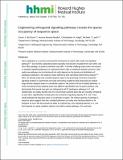Engineering orthogonal signalling pathways reveals the sparse occupancy of sequence space
Author(s)
McClune, Conor J.; Alvarez-Buylla, Aurora; Voigt, Christopher A.; Laub, Michael T.
DownloadAccepted version (4.557Mb)
Publisher Policy
Publisher Policy
Article is made available in accordance with the publisher's policy and may be subject to US copyright law. Please refer to the publisher's site for terms of use.
Terms of use
Metadata
Show full item recordAbstract
Gene duplication is a common and powerful mechanism by which cells create new signalling pathways1,2, but recently duplicated proteins typically must become insulated from each other and from other paralogues to prevent unwanted crosstalk3. A similar challenge arises when new sensors or synthetic signalling pathways are engineered within cells or transferred between genomes. How easily new pathways can be introduced into cells depends on the density and distribution of paralogous pathways in the sequence space that is defined by their specificity-determining residues4,5. Here we directly investigate how crowded this sequence space is, by generating novel two-component signalling proteins in Escherichia coli using cell sorting coupled to deep sequencing to analyse large libraries designed on the basis of coevolutionary patterns. We produce 58 insulated pathways comprising functional kinase–substrate pairs that have different specificities than their parent proteins, and demonstrate that several of these new pairs are orthogonal to all 27 paralogous pathways in E. coli. Additionally, from the kinase–substrate pairs generated, we identify sets consisting of six pairs that are mutually orthogonal to each other, which considerably increases the two-component signalling capacity of E. coli. These results indicate that sequence space is not densely occupied. The relative sparsity of paralogues in sequence space suggests that new insulated pathways can arise easily during evolution, or be designed de novo. We demonstrate the latter by engineering a signalling pathway in E. coli that responds to a plant cytokinin, without crosstalk to extant pathways. Our work also demonstrates how coevolution-guided mutagenesis and the mapping of sequence space can be used to design large sets of orthogonal protein–protein interactions.
Date issued
2019-10Department
Massachusetts Institute of Technology. Department of Biology; Massachusetts Institute of Technology. Department of Biological EngineeringJournal
Nature
Publisher
Springer Science and Business Media LLC
Citation
McClune, Conor J., et al. "Engineering orthogonal signalling pathways reveals the sparse occupancy of sequence space." Nature, 574, 7780 (October 2019): 702-706.
Version: Author's final manuscript
ISSN
0028-0836
1476-4687